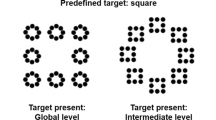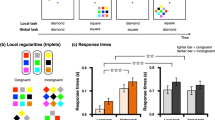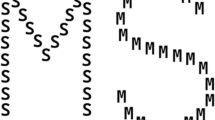Abstract
This study explores possible links between ontogenetic and microgenetic change (Werner, 1948, 1957) in the perception of stimuli with multiple levels of structure. Visual search for targets defined by local versus global structure was examined in observers aged 6, 8, 10, and 22 years. Perceptual access to each level of structure was varied by using pattern elements of same (easy) or opposite contrast polarity (hard); attentional processes were isolated from sensory processes by varying the number of display items. The results showed large improvements with age in search rates for global targets, with search rates for local targets being more constant over age. This pattern held regardless of whether perceptual access to a target was easy or hard. These results support the view that the perception of local and global structure involves different underlying processes.
Similar content being viewed by others
REFERENCES
Ames, L. B., Metraux, R. W., Rodell, J. L., & Walker, R. N. (1974). Child Rorschach responses: Developmental trends from two to ten years. New York: Brunner/Mazel.
Aslin, R. N. (1985). Oculomotor measures of visual development. In G. Gottlieb, N. Krasnegor (Eds.), Measurement of audition and vision in the first year of postnatal life: A methodological overview (pp. 391–417). Ablex Publishing Corp: Norwood NJ.
Aslin, R. N., & Smith, L. B. (1988). Perceptual development. Annual Review of Psychology, 39, 435–473.
Austen, E. & Enns, J. T. (in press). The role of “gaze detail ” in change blindness during full and divided attention.
Burack, J. A. (1997). The study of atypical and typical populations in developmental psychopathology: The quest for a common science. In S. S. Luthar, J. A. Burack, D. Cicchetti, & J. R. Weisz (Eds.), Developmental Psychopathology: Perspectives on adjustment, risk and disorder (pp.139–165). Cambridge, UK: Cambridge University Press.
Burack, J. A., Enns, J. T., Iarocci, G., & Randolph, B. (in press). Age differences in visual search for compound patterns: Long versus short range grouping, Developmental Psychology.
Cicchetti, D. (1984). The emergence of developmental psychopathology. Child Development, 55, 1–7.
Cicchetti, D., Rogosh, F. A., & Toth, S. L. (1997). Ontogenesis, depressotypic organization, and the depressive spectrum. In S. S., Luthar, J. A., Burack, D. Cicchetti, J. R Weisz (Eds.), Developmental psychopathology: Perspectives on adjustment, risk and disorder (pp. 273–316). Cambridge, UK: Cambridge University Press.
Cohen, L. B., & Younger, B. A. (1984). Infant perception of angular relations. Infant Behavior & Development, 7, 37–47.
Coren, S., Ward, L. M., & Enns, J. T. (1999). Sensation & perception (5th ed.). New York: Harcourt Brace.
Duncan, J., & Humphreys, G. W. (1989). Visual search and stimulus similarity. Psychological Review, 96, 433–458.
Enns, J. T. (1990). Relations between components of visual attention. In J. T. Enns (Ed.), The development of attention: Research and theory (pp. 139–158). New York: Elsevier.
Enns, J. T., & Burack, J. A. (1997). Attention, development and psychopathology: Bridging disciplines. In J. A. Burack & J. T. Enns (Eds.), Attention, development and psychopathology (pp. 3–28). New York: Guilford Press.
Enns, J. T., & Girgus, J. S. (1985). Developmental changes in selective and integrative visual attention. Journal of Experimental Child Psychology, 40, 319–337.
Enns, J. T., & Kingstone, A. (1995). Access to global and local properties in visual search for compound stimuli. Psychological Science, 6, 283–291.
Enns, J. T., & Kingstone, A. (1995). Access to global and local properties in visual search for compound stimuli. Psychological Science, 6, 283–291.
Fantz, R. L. (1961). The origin of form perception. Scientific American, 204, 66–72.
Ghent, L. (1956). Perception of overlapping and embedded figures by children of different ages. American Journal of Psychology, 69, 575–587.
Ghim, H., & Eimas, P. D. (1988). Global and local processing by 3-and 4-month-old infants. Perception & Psychophysics, 43, 165–171.
Gibson, E. J. (1969). Principles of perceptual learning and development. New York: Appleton-Century-Crofts.
Gibson, E. J., Gibson, J. J., Pick, A. D., Osser, H. A. (1962). A developmental study of the discrimination of letter-like forms. Journal of Comparative and Physiological Psychology, 55, 897–906.
Johnson, M. H., & Vecera, S. P. (1996). Cortical differentiation and neurocognitive development: The parcellation conjecture. Behavioural Processes, 36, 195–212.
Kemler, D. G. (1989). The nature and occurence of holistic processing. In B. E. Shepp & S. Ballestros (Eds.), Object perception: Structure & process (pp. 357–386). Hillsdale, N.J: Erlbaum.
Kimchi, R. (1992). Primacy of wholistic processing and global/ local paradigm: A critical review. Psychological Bulletin, 112, 24–38.
Kinchla, R. A., & Wolfe, J. M. (1979). The order of visual processing: “Top down ”, “bottom up” or “middle out.” Perception and Psychophysics, 25, 225–231.
Lamb, M. R., & Robertson, L. C. (1990). The effect of visual angle on global and local reaction times depends on the set of visual angles presented. Perception and Psychophysics, 47, 489–496.
Martin, M. (1979). Local and global processing: The role of sparsity. Memory & Cognition, 7, 476–484.
Navon, D. (1977). Forest before trees: The precedence of global features in visual perception. Cognitive Psychology, 9, 353–383.
Navon, D. (1981a). Do attention and decision follow perception? Comment on Miller. Journal of Experimental Psychology: Human Perception and Performance, 7, 1175–1182.
Navon, D. (1981b). The forest revisited: More on global precedence. Psychological Research, 43, 132.
Navon, D. (1983). How many trees does it take to make a forest? Perception, 12, 239–254.
Plude, D., Enns, J. T., & Brodeur, D. A. (1994). The development of selective attention:Alife span overview. Acta Psychologica, 86, 227–272.
Quinn, P. C., & Eimas, P. D. (1986). Pattern-line effects and units of visual processing in infants. Infant Behavior & Development, 9, 57–70.
Shepp, B. E. (1978). From perceived similarity to dimensional structure: A new hypothesis about perceptual development. In E. Rosch & B. Lloyd (Eds.), On the nature and principle of formation of categories. Hillsdale, NJ: Erlbaum.
Smith, J. D., (1989). Analytic and holistic processing in categorization. In B. E. Shepp & S. Ballestros (Eds.), Object perception: Structure & process (pp. 297–323). Hillsdale, NJ: Erlbaum.
Smith, L. B. (1991). A model of perceptual classification in children and adults. Psychological Review, 96, 125–144.
Smith, J. D., & Kemler, D. G. (1977). Developmental trends in free classification: Evidence for a new conceptualization of perceptual development. Journal of Experimental Child Psychology, 22, 279–298.
Spelke, E. S. & Breinlinger, K. (1993). Gestalt relations and object perception: A developmental study. Perception, 22, 1483–1501.
Sternberg, S. (1969). The discovery of processing stages: Extensions of Donder's method. Acta Psychologica, 30, 276–315.
Stiles, J., Delis, D. C., & Tada, W. (1991). Global and local processing in preschool children. Child Development, 61, 1258–1275.
Titchener, E. (1909). Experimental psychology of the thought process. New York: Macmillan.
Treisman, A., & Gelade, G. (1980). A feature-integration theory of attention. Cognitive Psychology, 12, 97–136.
Trick, L. M., & Enns, J. T. (1997). Clusters precede shapes in perceptual organization. Psychological Science, 8, 124–129.
Uttal, W. R. (1994). Pattern recognition. In V. S. Ramachandran (Ed.), The encyclopedia of human behaviour (Vol. 3, pp. 421–429). New York: Academic Press.
Ward, L. M. (1982). Determinants of attention to local and global features of visual forms. Journal of Experimental Psychology: Human Perception and Performance, 8, 562–581.
Ward, L. M. (1983). On processing dominance: Comment on Pomerantz. Journal of Experimental Psychology: General, 112, 541–546.
Ward, T. B. (1988). When is category learning holistic? A reply to Kemler-Nelson. Memory and Cognition, 16, 85–89.
Ward, T. B., & Scott, J. (1987). Analytic and holistic modes of learning family-resemblance concepts. Memory and Cognition, 15, 42–54.
Ward, T. B., & Vela, E. (1986). Classifying color materials: Children are less holistic than adults. Journal of Experimental Child Psychology, 42, 273–302.
Werker, J. (1991) The ontogeny of speech perception. In I. G. Mattingly, M. Studdert-Kennedy (Eds.), Modularity and the motor theory of speech perception (pp. 99–109). Hillsdale, NJ: Erlbaum.
Werner, H. (1948). Comparative psychology of mental development. New York: International Universities Press.
Werner, H. (1957). The concept of development from a comparative and organismic point of view. In D. B. Harris (Ed.), The concept of development (pp. 125–148). Minneapolis: University of Minnesota Press.
Wertheimer, M. (1955). Gestalt theory. In W. D. Ellis (Ed.), A source book of Gestalt psychology (pp. 1–11). New York: Humanities Press (Originally published in 1925).
Wickens, C. D. (1974). Temporal limits of human information processing: A developmental study. Psychological Bulletin, 81, 739–755.
Wolfe, J. M., Cave, K. R., & Franzel, S. L. (1989). Guided search: An alternative to the feature integration model for visual search. Journal of Experimental Psychology: Human Perception and Performance, 15, 419–433.
Zaporozhets, A. V. (1965). Psychology (3rd ed). Moscow: Prosveshchenie.
Rights and permissions
About this article
Cite this article
Enns, J.T., Burack, J.A., Iarocci, G. et al. The Orthogenetic Principle in the Perception of “Forests” and “Trees”?. Journal of Adult Development 7, 41–48 (2000). https://doi.org/10.1023/A:1009503118377
Issue Date:
DOI: https://doi.org/10.1023/A:1009503118377




